| Listing 1 - 10 of 10 |
Sort by
|
Book
ISBN: 1589837835 1589837827 9781589837836 9781589837829 9781589837843 1589837843 Year: 2013 Publisher: Atlanta
Abstract | Keywords | Export | Availability | Bookmark
 Loading...
Loading...Choose an application
- Reference Manager
- EndNote
- RefWorks (Direct export to RefWorks)
Wisdom literature --- Criticism, interpretation, etc. --- History and criticism --- 4QInstruction. --- Sapiential work A --- Musar le-mevin --- Instruction (Dead Sea scroll) --- Mûsār le̳Mēvîn --- Dead Sea scrolls. --- 1Q/4QInstruction
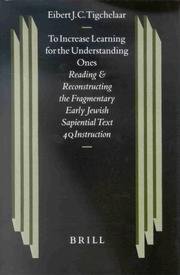
ISBN: 9004116788 900435042X Year: 2001 Volume: 44 Publisher: Leiden ; Boston : Brill,
Abstract | Keywords | Export | Availability | Bookmark
 Loading...
Loading...Choose an application
- Reference Manager
- EndNote
- RefWorks (Direct export to RefWorks)
This study aims at furthering our understanding of the early Jewish sapiential composition 4QInstruction which was found in fragmentary manuscripts at Qumran. The first part focuses on the reading and joining of the fragments, and gives an approximate reconstruction of the manuscripts and the composition. The second part discusses some disputed sections and themes in more detail, especially the beginning of the composition (4Q416 1), its relation to the Community Rule and the Hodayot, alleged sacerdotal fragments (4Q415 1 ii-2 I and 4Q418 81), as well as fragments describing fate after death (4Q418 55 and 69 ii). The first part is intended as a supplement to the official DJD edition, whereas the second part is of a more general interest.
4QInstructie --- 4QInstruction --- Dead Sea scrolls. 4Q. 4QInstruction --- Instruction (Dead Sea scroll) --- Musar le-mevin --- Sapiential work A --- 229*317 --- Qumran en het Oude Testament --- 229*317 Qumran en het Oude Testament --- Judaism --- Wisdom --- Experience --- Intellect --- Learning and scholarship --- Reason --- Jewish theology --- Theology, Jewish --- Doctrines --- Religious aspects&delete& --- 4QInstruction. --- Mûsār le̳Mēvîn --- Dead Sea scrolls. --- 1Q/4QInstruction --- Religious aspects --- Judaism. --- Doctrines.
Book
ISBN: 9789004361447 9004361448 9789004364240 9004364242 Year: 2018 Publisher: Leiden Boston
Abstract | Keywords | Export | Availability | Bookmark
 Loading...
Loading...Choose an application
- Reference Manager
- EndNote
- RefWorks (Direct export to RefWorks)
In 4QInstruction: Divisions and Hierarchies , Benjamin Wold challenges the interpretation of 4QInstruction as a deterministic and dualistic composition. In a re-examination of key fragments he offers new reconstructions and translations that indicate 4QInstruction envisaged wisdom available to all humanity, divisions among humankind and communities as the result of individual adherence to wisdom, and a hierarchy of authority as a result of individual merit.
Wisdom --- Judaism --- 229*3 --- 229*3 Dode Zeerollen en intertestamentaire literatuur --- Dode Zeerollen en intertestamentaire literatuur --- Jewish theology --- Theology, Jewish --- Religious aspects&delete& --- Doctrines --- 4QInstruction. --- Sapiential work A --- Musar le-mevin --- Instruction (Dead Sea scroll) --- Mûsār le̳Mēvîn --- Dead Sea scrolls. --- 1Q/4QInstruction --- Experience --- Intellect --- Learning and scholarship --- Reason --- Religious aspects --- Judaism. --- Doctrines.
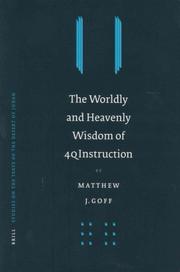
ISBN: 900413591X 9004350489 Year: 2003 Volume: 50 Publisher: Leiden ; Boston : Brill,
Abstract | Keywords | Export | Availability | Bookmark
 Loading...
Loading...Choose an application
- Reference Manager
- EndNote
- RefWorks (Direct export to RefWorks)
This volume is devoted to 4QInstruction, the last lengthy text of the Dead Sea Scrolls to be officially published. It is also the largest wisdom text of this corpus. The central concern of this study is how this composition should be understood in relation to the sapiential and apocalyptic traditions. Features of 4QInstruction that are examined include its appeal to revelation, its presentation of poverty, and its eschatology. The document’s relationship to both 1 Enoch and the Dead Sea sect is also discussed. This study will prove useful to anyone interested in the Dead Sea Scrolls, the reception of the Jewish wisdom tradition in the Second Temple period, and apocalypticism.
4QInstructie --- 4QInstruction --- Dead Sea scrolls. 4Q. 4QInstruction --- Instruction (Dead Sea scroll) --- Musar le-mevin --- Sapiential work A --- 229*317 --- Wisdom --- -Judaism --- -Jews --- Religions --- Semites --- Jews --- Experience --- Intellect --- Learning and scholarship --- Reason --- Qumran en het Oude Testament --- Religious aspects --- Doctrines --- Religion --- -Qumran en het Oude Testament --- 229*317 Qumran en het Oude Testament --- -229*317 Qumran en het Oude Testament --- Judaism --- Jewish theology --- Theology, Jewish --- Religious aspects&delete& --- 4QInstruction. --- Mûsār le̳Mēvîn --- Dead Sea scrolls. --- 1Q/4QInstruction --- Judaism. --- Doctrines.
Book
ISBN: 9789004172685 9004172688 9786612400766 1282400762 9047426150 9789047426158 Year: 2009 Volume: 81 Publisher: Leiden Boston Brill
Abstract | Keywords | Export | Availability | Bookmark
 Loading...
Loading...Choose an application
- Reference Manager
- EndNote
- RefWorks (Direct export to RefWorks)
This volume consists of an edition, a translation and a commentary of the most important fragments of 4QInstruction. Initially it deals with the linguistic characteristics of the scroll highlighting the links between 4QInstruction and Ben Sira, and also with the Community Rule and the Hodayot. It then investigates the Sapiential fragments dealing with poverty, husband-wife and parent-child relationships. Finally it examines the eschatological fragments. The work seeks to improve the edition and understanding of this fundamental text enhancing our knowledge of the history and development of thinking at Qumran. Moreover, it examines links which 4QInstruction establishes between purely Sapiential discourse and descriptions of eschatological judgement. This study substantially illuminates our understanding of the Wisdom movement in the early intertestamental period.
Wisdom --- Judaism --- 229*317 --- 229*317 Qumran en het Oude Testament --- Qumran en het Oude Testament --- Jewish theology --- Theology, Jewish --- Experience --- Intellect --- Learning and scholarship --- Reason --- Religious aspects --- Judaism. --- Doctrines. --- 4QInstruction. --- Sapiential work A --- Musar le-mevin --- Instruction (Dead Sea scroll) --- Mûsār le̳Mēvîn --- Dead Sea scrolls. --- 1Q/4QInstruction --- Sagesse --- Judaïsme --- Aspect religieux --- Christianisme --- Histoire des doctrines --- Doctrines --- Religious aspects&delete&
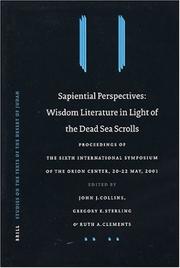
ISSN: 01699962 ISBN: 9004136703 9047412753 9789004136700 Year: 2004 Volume: 51 Publisher: Leiden: Brill,
Abstract | Keywords | Export | Availability | Bookmark
 Loading...
Loading...Choose an application
- Reference Manager
- EndNote
- RefWorks (Direct export to RefWorks)
The papers in this volume were originally read at the Sixth International Orion Symposium. The primary focus of the volume is on the wisdom texts from Qumran that have been fully edited only in recent years, especially 1Q/4QMysteries and 4QInstruction. Prior to the discovery of the Scrolls, our knowledge of wisdom literature in the Second Temple period was limited to contemporary biblical books, apocryphal works, and pseudepigraphical writings. These recently published compositions now allow for a more nuanced picture of wisdom literature and its impact on and interaction with other genres. In addition to shedding light on the world of their authors, these texts illustrate how biblical wisdom was reused in new contexts, and provide a missing link between earlier and later sapiential compositions.
Wisdom --- Religious aspects --- Judaism --- 4QInstruction --- 4QMysteries --- Dead Sea scrolls --- 229*317 --- Qumran en het Oude Testament --- 229*317 Qumran en het Oude Testament --- Experience --- Intellect --- Learning and scholarship --- Reason --- Jerusalem scrolls --- ʻAin Fashka scrolls --- Jericho scrolls --- Scrolls, Dead Sea --- Qumrân scrolls --- Rękopisy z Qumran --- Shikai bunsho --- Megilot Midbar Yehudah --- Dodezee-rollen --- Kumránské rukopisy --- Documentos de Qumrán --- Textos de Qumrán --- Rollos del Mar Muerto --- Manuscritos del Mar Muerto --- Manuscrits de la mer Morte --- Dödahavsrullarna --- Kumranin kirjoitukset --- Kuolleenmeren kirjoitukset --- Qumranhandskrifterna --- Qumranin kirjoitukset --- Qumran Caves scrolls --- 1Q/4QMysteries --- Mysteries (Dead Sea scroll) --- Dead Sea scrolls. --- Sapiential work A --- Musar le-mevin --- Instruction (Dead Sea scroll) --- Mûsār le̳Mēvîn --- 1Q/4QInstruction --- Congresses --- Dead Sea Scrolls --- Judaism. --- 4QInstruction. --- 4QMysteries. --- Wisdom - Religious aspects - Judaism - Congresses.
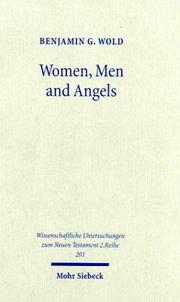
ISBN: 3161486919 9783161486913 Year: 2005 Volume: 201 Publisher: Tübingen Mohr
Abstract | Keywords | Export | Availability | Bookmark
 Loading...
Loading...Choose an application
- Reference Manager
- EndNote
- RefWorks (Direct export to RefWorks)
Women --- Theological anthropology --- Angels --- Religious aspects --- Judaism --- History. --- History of doctrines. --- 229*317 --- Qumran en het Oude Testament --- 229*317 Qumran en het Oude Testament --- Anthropology, Doctrinal --- Anthropology, Theological --- Body and soul (Theology) --- Doctrinal anthropology --- Humanity, Doctrine of --- Man, Doctrine of --- Man (Theology) --- Mankind, Doctrine of --- Religion --- Angelology --- Cherubim --- Cherubs (Spirits) --- Divine messengers --- Seraphim --- Spirits --- Human females --- Wimmin --- Woman --- Womon --- Womyn --- Females --- Human beings --- Femininity --- Judaism&delete& --- History of doctrines --- Religious aspects&delete& --- History --- 4QInstruction --- Bible. --- Sapiential work A --- Musar le-mevin --- Instruction (Dead Sea scroll) --- Mûsār le̳Mēvîn --- Dead Sea scrolls. --- 1Q/4QInstruction --- Criticism, interpretation, etc. --- Women - Religious aspects - Judaism - History. --- Theological anthropology - Judaism - History of doctrines. --- Angels - Judaism - History of doctrines.
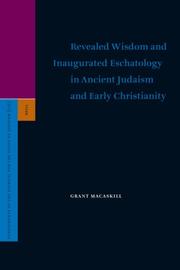
ISBN: 9789004155824 9004155821 9786611917197 1281917192 9047419243 9789047419242 9781281917195 6611917195 Year: 2007 Volume: 115 Publisher: Leiden Boston Brill
Abstract | Keywords | Export | Availability | Bookmark
 Loading...
Loading...Choose an application
- Reference Manager
- EndNote
- RefWorks (Direct export to RefWorks)
This book examines four texts: 1 Enoch, 4QInstruction, Matthew and 2 Enoch. A common idea in these texts, which blend sapiential and apocalyptic elements, is that the revealing of wisdom to an elect group inaugurates the eschatological period. The emphasis on “revealed wisdom” is essentially apocalyptic, but facilitates the uptake of motifs, forms and language from the sapiential tradition and is important in explaining the fusion of the two traditions. In addition, revealed wisdom often has creational associations and this has significance for the notion of ethics in these texts. The book will interest anyone concerned with the development of Jewish and Christian eschatology and ethics. It also challenges the simplistic redactional assumptions of certain New Testament scholars.
Wisdom --- Eschatology. --- 236 --- Last things (Theology) --- Religious thought --- Theology, Doctrinal --- Religious aspects. --- Eschatologie. De novissimis --- Ethiopic book of Enoch --- 4QInstruction. --- Bible. --- Evangelie volgens Matteus --- Evangelie volgens Matthéüs --- Matʻae pogŭm --- Matai den --- Matai ni yoru fukuinsho --- Matius (Book of the New Testament) --- Mattá --- Matteo (Book of the New Testament) --- Matteus --- Matthäusevangelium --- Matthéüs --- Matthew (Book of the New Testament) --- Matthieu (Book of the New Testament) --- Sapiential work A --- Musar le-mevin --- Instruction (Dead Sea scroll) --- Mûsār le̳Mēvîn --- Dead Sea scrolls. --- 1Q/4QInstruction --- Book of Enoch, Ethiopic --- Enoch, Ethiopic Book of --- Book of the Ethiopic Enoch --- Äthiopischer Henoch --- Buch Henoch --- 1 Enoch (Apocryphal book) --- First Enoch (Apocryphal book) --- 1st Enoch (Apocryphal book) --- Criticism, interpretation, etc. --- Eschatology --- Eschatology, Jewish. --- Judaism --- Dogma. --- Eschatologie --- Eschatologie juive --- Judaïsme --- Dogme --- Doctrines. --- Doctrines --- Slavonic book of Enoch --- 4QInstruction --- Religious aspects
Book
ISBN: 9783110303827 9783110304039 3110303825 Year: 2013 Volume: 197 Publisher: Berlin Boston
Abstract | Keywords | Export | Availability | Bookmark
 Loading...
Loading...Choose an application
- Reference Manager
- EndNote
- RefWorks (Direct export to RefWorks)
Bible --- 4QInstruction --- Thanksgiving Psalms --- Criticism, interpretation, etc --- 227.1*6 --- 227*22 --- 227*22 Brieven van Petrus --- Brieven van Petrus --- 227.1*6 Brief van Paulus aan de Colossenzen. Brief van Paulus aan Philemon --- Brief van Paulus aan de Colossenzen. Brief van Paulus aan Philemon --- 4QInstruction. --- Bible. --- Thanksgiving Psalms. --- Dead Sea scrolls. --- Hodayot --- Hodayoth --- Hymns of thanksgiving --- Megilat hodayot --- Psalms of thanksgiving --- Scroll of thanksgivings --- Scroll of the hymns --- Thanksgiving hymns --- Thanksgiving scroll --- Epistle of Peter, 1st --- Peter, 1st (Book of the New Testament) --- Peter (Book 1) --- Colossians (Book of the New Testament) --- Kolosserbrief (Book of the New Testament) --- Sapiential work A --- Musar le-mevin --- Instruction (Dead Sea scroll) --- Mûsār le̳Mēvîn --- 1Q/4QInstruction --- Criticism, interpretation, etc.
Book
ISSN: 09342575 ISBN: 9783110477276 3110477270 9783110483604 9783110482430 Year: 2020 Volume: 496 Publisher: Berlin Boston
Abstract | Keywords | Export | Availability | Bookmark
 Loading...
Loading...Choose an application
- Reference Manager
- EndNote
- RefWorks (Direct export to RefWorks)
Scholars of the Hebrew Bible used to look at „Prophecy" and „Wisdom" as clearly distinct realms represented by antagonistic and mutually exclusive roles of their central characters: the loyal sage, the pillar of administration, on the one side and the rebellious prophet, criticizing the establishment, on the other. While the influence of wisdom thought on prophetic texts has been a topic in the scholarly debate, the complementary question of the influence of prophetic thought on wisdom texts has rarely been asked. The contributions in this volume look at both questions: They start from the assumption that texts from the Hebrew Bible and the cultures surrounding Ancient Israel all originated from a social stratum of educated scribes, who authored and transmitted these texts. It then seems plausible that wisdom texts might show similar traces of prophetic influence to those of wisdom thoughts found in prophetic texts. The essays give a multifaceted picture concerning the mutual perception of prophets and sages and thus provide a deeper understanding of both wisdom literature and prophecy.
Scribes, Jewish --- Wisdom literature --- Jewish religious literature --- 221.08*3 --- 223.7 --- 223.4 --- 223.5 --- Sofer --- Soferim --- Sofrim --- Sopher --- Sopherim --- Sophrim --- Judaism --- 223.5 Ecclesiaste --- 223.5 Prediker. Qohelet (Ecclesiastes) --- Ecclesiaste --- Prediker. Qohelet (Ecclesiastes) --- 223.4 Boek der Spreuken --- 223.4 Les Proverbes --- Boek der Spreuken --- Les Proverbes --- 223.7 La Sagesse. Ecclesiastique --- 223.7 Wijsheid. Wijsheid van Jesus Sirach (Ecclesiasticus) --- La Sagesse. Ecclesiastique --- Wijsheid. Wijsheid van Jesus Sirach (Ecclesiasticus) --- 221.08*3 Theologie van het Oude Testament: themata --- Theologie van het Oude Testament: themata --- History --- Criticism, interpretation, etc --- History and criticism --- Functionaries --- Bible. --- 4QInstruction --- Sapiential work A --- Musar le-mevin --- Instruction (Dead Sea scroll) --- Mûsār le̳Mēvîn --- Dead Sea scrolls. --- 1Q/4QInstruction --- Book of the twelve Minor Prophets (Books of the Old Testament) --- Minor Prophets (Books of the Old Testament) --- Tere ʻaśar (Books of the Old Testament) --- Twelve Prophets (Books of the Old Testament) --- Neviʼim --- Prophets (Neviʼim) --- Later Prophets --- Latter Prophets --- Neviʼim aḥaronim --- Nevym achronim --- Prophetae Posteriores --- Prophets (Books of the Old Testament) --- Yeŏnsŏ --- Criticism, interpretation, etc.
| Listing 1 - 10 of 10 |
Sort by
|

 Search
Search Feedback
Feedback About UniCat
About UniCat  Help
Help News
News